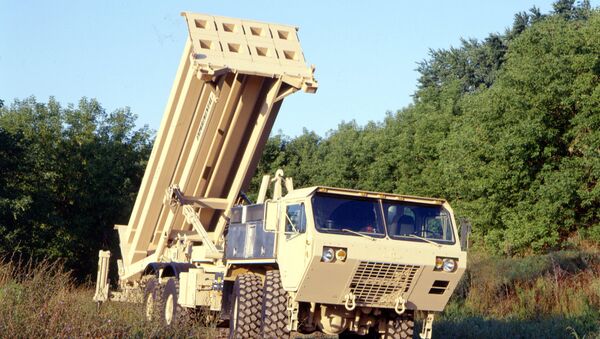The Terminal High Altitude Area Defense (THAAD) deployment to Seongju County, South Korea, threatens to undermine the stability in East Asia and beyond, according to Chinese arms control expert Teng Jianqun of the China Institute of International Studies (CIIS).
In an interview with China Central Television (CCTV), broadcaster Teng drew attention to the fact that despite Washington and Seoul pledging that the system is aimed against the Democratic People's Republic of Korea, in fact the THAAD installation in the Korean Peninsula is part of the US global missile defense system.
"This is one part of a global missile defense program of the United States. Actually, there is a missile defense deployment in Europe and, as we have witnessed, in Romania, Poland, and in the Asia Pacific region. I am sure South Korea is the most important point to deploy such a system. If we look at the map we can find out that the US has already deployed the THAAD system in Alaska and Japan and there might be another deployment in the Philippines. So I think this is actually a global plan by the United States," Teng stressed.
Why is Beijing concerned about the THAAD deployment in South Korea?
In his February article Panda explained that the THAAD installation in South Korea could improve early tracking of some Chinese missiles due to the system's capability of gathering surveillance data and transferring it to other US BMD assets.
"So, from the Chinese perspective, a THAAD deployment could shift the strategic stability needle ever so slightly away from its status quo equilibrium and benefit the United States, giving Washington better early warning and tracking of Chinese ICBMs," Panda elaborated.

However, this is not as harmless as it looks.
Tian Dongdong of Xinhua specifies that deploying THAAD in South Korea is a crucial step to fill the gap in Washington's anti-missile missile system in the Asia Pacific, "which has long been nagged by its inadequate recognition ability."
The Chinese journalist points out that if placed in South Korea THAAD's X band radar would cover the territory over 1,200 miles (1,900 kilometers) from the peninsula, i.e. half of China's territory and the southern part of Russia's Far East. That means the Pentagon will be able to significantly improve the recognition accuracy.
But this is half the story, according to Tian: "If deployed, THAAD could help the US Army to collect radar data of warheads and decoys of China and Russia's strategic missiles by monitoring their experiments, thus enabling the United States to neutralize their nuclear deterrence."
Citing Cheong Wooksik, director of Peace Network, a South Korean civic group, Xinhua noted Friday that THAAD is designed to intercept missiles at a "relatively high altitude of 40 to 150 kilometers" (25 to 93 miles). But the DPRK's rockets fly at an altitude of about 20 kilometers (12 miles). That means the THAAD system would simply not be able to shoot them down.
Speaking to CCTV, Teng Jianqun also stressed that Seoul is using the THAAD deployment as a bargaining chip to persuade Beijing to exert further pressure on North Korea so that the latter suspends its nuclear program.
"So I think this is a very controversial plan by the United States and actually the ROK (Republic of Korea) accepted it and it will [threaten] the stability among major powers," Teng emphasized.
He pointed out that the reaction of Beijing and Moscow to Seoul's decision to kick off the US missile defense program in South Korea was prompted by the countries' growing concerns that the THAAD deployment will undermine the stability in the East Asia region and beyond.
It should be noted that Moscow has repeatedly warned Washington that the implementation of the THAAD system in South Korea would be considered "as an attempt to undermine the existing parity in the nuclear field".
Answering the question whether the deployment would hurt economic ties with China, Teng noted that South Korea "should be priced for the acceptance of the deployment of the THAAD system in their country."





